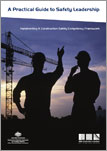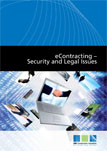
Download report [Adobe Reader 8 or higher recommended: Download latest version ]

 A practical guide to safety leadership(Includes A Construction Safety Competency Framework)$66.00 (inc GST)
A practical guide to safety leadership(Includes A Construction Safety Competency Framework)$66.00 (inc GST)Download report [Adobe Reader 8 or higher recommended: Download latest version ]
The follow-up resource to A Construction Safety Competency Framework: Improving OH&S performance by creating and maintaining a safety culture. The guide is a useful tool to help industry apply the principles of safety culture within their organisations. It examines the safety critical positions and the safety management tasks outlined in the competency framework and combines practical examples and case studies to assist organisations in identifying behaviours and approaches which need improvement. $27.50 (inc GST)Download full report (1.6MB) [Adobe Reader 8 or higher recommended: Download latest version ]
$27.50 (inc GST)Download full report (1.6MB) [Adobe Reader 8 or higher recommended: Download latest version ]
Provides an overview of various legal and security matters relevant to eContracting by examining the eContracting process, the requisite security goals to be achieved and the various systems that may be used to conduct eContracting. It also covers the relevant legal principles, analyses of the legal and security risks and makes practical recommendations.
The Risks and Recommendations Solutions chart is provided to you for use within your organisation as a checklist of current risk mitigation measures or to plan for implementation of electronic contract administration by providing a framework to identify your organisation’s specific solution requirements.
[Adobe Reader 8 or higher recommended: Download latest version ]An accessible version for vision impaired users designed for use with screen reader software is available at: Wayfinding design guidelines (accessible version).Wayfinding system audit
$16.50 (inc GST)
An accessible version for vision impaired users designed for use with screen reader software is available: Wayfinding system audit (accessible version).
Off-site manufacture in Australia: Current state and future directions
$27.50 (inc GST)
Although numerous reports have been produced in the UK on the state of off-site manufacture adoption, no prominent studies exist for the Australian context. This scoping study that lead to this publication is an essential component on which to build any initiatives that can take advantage of the benefits of OSM in construction. It confirms the benefits and identifies the real and perceived barriers to widespread adoption of OSM, and identifies opportunities for future investment and research.
Guide to Best Practice for Safer Construction: Implementation Kit
The Guide to Best Practice for Safer Construction has been developed following a detailed review of practical Australian and international best practice initiatives.
The Guide provides a framework to improve safety performance on construction projects and covers all stages of a project: planning, design, construction and post-construction. Its overarching objective is to reduce the number of accidents and deaths on construction sites and to improve the ability of the industry as a whole to deliver safer construction projects and healthier employees.The three primary stakeholder groups of the construction industry - clients, designers and constructors - have worked together to create a methodology which integrates occupational health and safety into strategic and operational decision-making at all stages of the project.The Guide is intended to be an aspirational document that leads discussion and industry change, as well as a practical tool which can be used across the industry, by clients, designers and constructors and by large firms and small and medium-sized enterprises.
$27.50 (inc GST) - for hard copyThis second industry report to be developed from the Sydney Opera House FM Exemplar project series,provides a comprehensive overview of the digital modelling research stream of the project led by John Mitchell, principal of the consulting company CQR Pty Ltd and consultant to Construction Innovation's research partner CSIRO, which focuses on the application of Construction ICT, specialising in BIM and open standard model sharing such as IFC.
This research demonstrates significant benefits in digitising design documentation and operational and maintenance manuals and focuses on:
- Re-usability of standardised BIM for FM purposes
- Potential of BIM as an information framework acting as an integrator for various FM data sources
- Flexibility of BIM to cope with business-specific data and requirements
- Commercial FM software using standarised BIM
- The ability to add (organisation-specific) intelligence to the model
- A roadmap for Sydney Opera House to adopt BIM for FM.
$35.75 (inc GST) - for hard copySydney Opera House is recognised throughout the world as a building icon of 20th century architecture. The CRC for Construction Innovation and the Australian Governments FM Action Agenda chose this iconic symbol as the focus of the Facilities Management (FM) Exemplar Project and partnered with industry, government and research to develop innovative strategies across three research themes.
1. Digital modelling
2. Services procurement
3. Performance benchmarkingBy focussing on different dimensions of the management equation, FM as a business enabler showcases innovative methods for improving FM performance, a better alignment of service and performance objectives and provides a best-practice model for supporting the business enterprise.Sustainable subdivisions: Review of technologies for integrated water services
$19.25 (inc GST) for hard copyby Clare Diaper, Grace Tjandraatmadja and Steven KenwayImproved planning and management of water in Australia is essential to ensure reliability of water services and to support ongoing growth of our cities. Sustainable Subdivisions: Review of technologies for integrated water services deals with emerging water supply, wastewater treatment and reuse technologies at household, cluster and subdivisional scales.HVAC system size: Getting it rightby PC Thomas and Steven MollerDownload HVAC System size: Getting it right(1 Mb)
Many heating, ventilating and air-conditioning (HVAC) systems installed in commercial buildings, have more capacity than is ever required to keep the occupants comfortable. Such oversized HVAC systems can have negative effects on the environment, on occupant comfort, as well as on the economic outcomes for the building. Drawing on case studies of the HVAC systems of two large office and the literature, the publication covers the symptoms of over-sizing, the impacts of over-sizing, the barriers to right-sizing and suggestions and solutions to reduce over-sizing.by Karen ManleyDownload Being the Best (1.50 Mb) View other BRITE publications
Being the Best investigates the ways in which highly innovative contractors sustain their market leadership. The businesses consulted are quoted extensively, as a means of sharing their insights. This report is intended as a resource for contractors that want to improve their innovation outcomes and business performance.by Karen ManleyDownload BRITE Innovation Gallery 2007 (1.10 Mb) View other BRITE publicationsThis report contains nine examples of project-based innovation drawn from the activities of the twenty contractors interviewed for the Being the Best report. In combination, the two reports provide a carefully targeted resource to help contractors improve their innovation outcomes, and hence their business performance.by Karen ManleyDownload Innovate now! (1.50 Mb) View other BRITE publications
Businesses should seek to work with leading edge clients to promote innovation. That's one piece of advice fromInnovate now!-- a new free guide for improving performance in the building and construction industry through innovation.By unpacking the elements of innovation, Innovate now! simplifies and demystifies the processes required for becoming more innovative. Construction industry representatives have commended the guide for uncovering innovation drivers and demonstrating that innovation is applicable to businesses of any size.
A Construction Safety Competency Framework: Improving OH&S performance by creating and maintaining a safety culture
(Included in A practical guide to safety leadership)by Donald P. Dingsdag, Herbert C. Biggs, Vaughn L. Sheahan and Dean J. Cipolla$49.50 (inc GST) - for hard copyDownload Executive Summary (1.4 Mb)Download full report (1.76 Mb)A Construction Safety Competency Framework: Improving OH&S performance by creating and maintaining a safety culture presents a clear way forward for the construction industry by promoting a consistent national standard to improve OH&S competency for key safety positions. It directly addresses the industrys safety culture and provides a process for significant cultural change and reduction of injury and incident rates.This industry-driven publication(and CD for easy content customisation) provides the information required by senior safety managers, senior managers and executives to implement the safety culture concept and to adapt it to suit their organisational requirements. By outlining the knowledge, skill and behaviour required of safety critical staff and the processes for achieving a change in safety culture, the framework paves the way for improving workplace safety in the industry.The technology that facilitates eTendering is relatively new and ever changing. As a consequence the law has not developed sufficiently to provide certainty of enforcement for electronic transactions. A need for further research into eTendering was identified byConstruction Innovation and this report is the result of that research. In addition to evaluating the legal, security and risk issues relating to eTendering, the report also aims to promote knowledge and awareness about ICT in the construction industry.- A practical database derived expert opinionby Ivan ColeDownload Predicted lifetimes of metallic building components (4.35 Mb)A reliable and accurate estimate of expected service life for building components is a crucial requirement for lifecycle and environmental impact tools that assist in lifecycle costing, eco-efficiency assessments and building maintenance. The Cooperative Research Centre for Construction Innovation has developed a database, derived from expert opinion, of predicted lifetimes for a range of metallic building components.by Graham Brewer and Thayaparan GajendranOverview (PICTURING SUCCESS critical success factors for ICT integration in the Australian construction industry) available as a Free download(1 Mb)
Communication and Technology (ICT). Energy-efficient design
by Anne Miller and Michael Ambrose$19.25 (incl. GST)Download Sustainable Subdivisions: Energy-efficient Design(12.6 Mb)The 35-page publication has been endorsed by the Environmental Protection Agency and the UDIA. It describes the relationship between subdivisional layout and a dwellings energy efficiency. Effective energy-efficient subdivisions will be more energy efficient than conventional developments. Energy-efficient dwellings should have lower demands on non-renewable energy sources, reduce the level of greenhouse gas emissions, and save money for owners and occupants.First published 2005 by the CRC for Construction Innovation, for Icon.Net Pty Ltd. ISBN 0 9750977 5 X?
by Stephen KajewskiThe successful implementation of electronic tendering systems and processes requires careful attention to the needs of the system and the concerns and requirements of the various stakeholders. This summary of the outcomes of an investigation into eTendering presents guidelines and recommendations to be considered when implementing eTendering systems, procedures and policies.